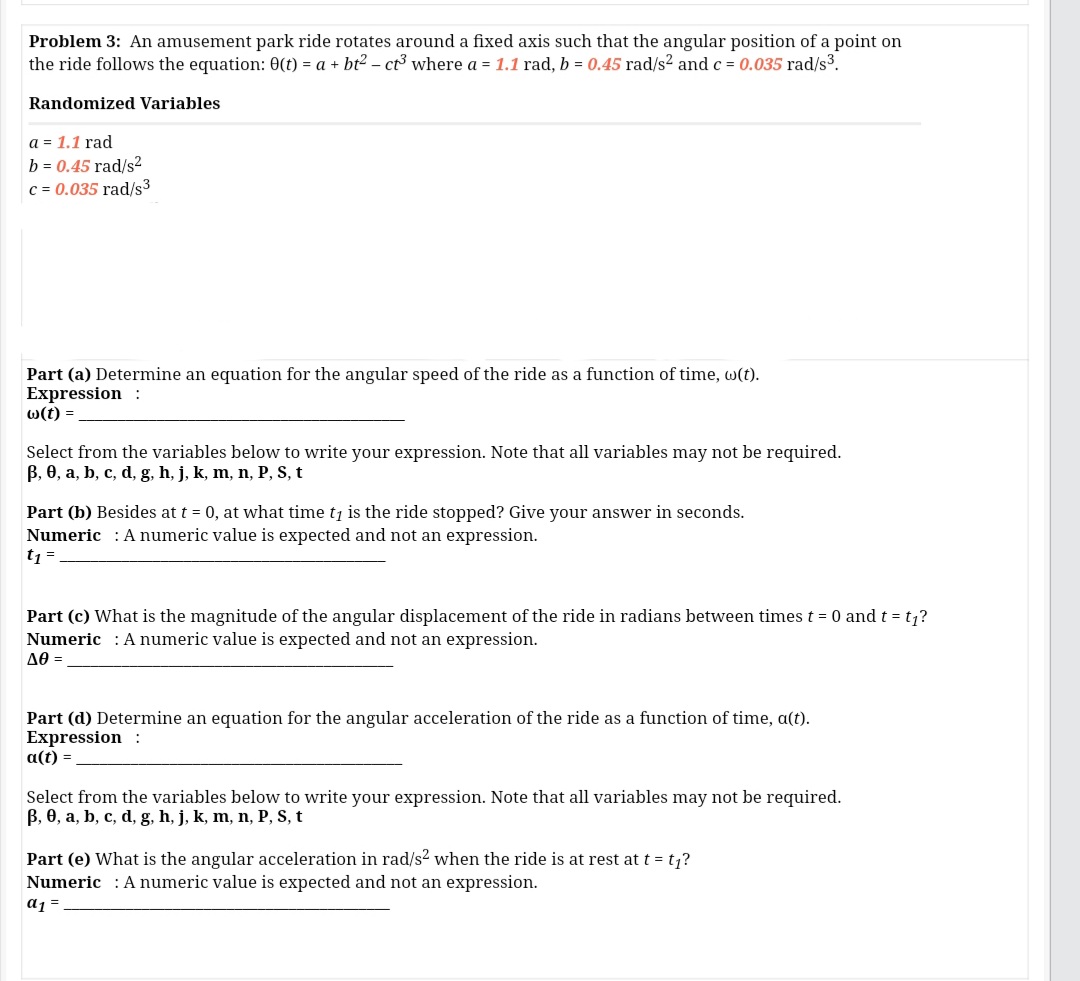Problem 3: An amusement park ride rotates around a fixed axis such that the angular position of a point on the ride follows the equation: 0(t) = a + bt2 - ct³ where a = 1.1 rad, b = 0.45 rad/s2 and c 0.035 rad/s3. Randomized Variables a = 1.1 rad b = 0.45 rad/s2 c = 0.035 rad/s3 Part (a) Determine an equation for the angular speed of the ride as a function of time, w(t). Expression : w(t) = Select from the variables below to write your expression. Note that all variables may not be required. B, 0, a, b, c, d, g, h, j, k, m, n, P, S, t Part (b) Besides at t 0, at what time tį is the ride stopped? Give your answer in seconds. Numeric : A numeric value is expected and not an expression. t = Part (c) What is the magnitude of the angular displacement of the ride in radians between times t = 0 and t = t? Numeric : A numeric value is expected and not an expression. A0 =
Problem 3: An amusement park ride rotates around a fixed axis such that the angular position of a point on the ride follows the equation: 0(t) = a + bt2 - ct³ where a = 1.1 rad, b = 0.45 rad/s2 and c 0.035 rad/s3. Randomized Variables a = 1.1 rad b = 0.45 rad/s2 c = 0.035 rad/s3 Part (a) Determine an equation for the angular speed of the ride as a function of time, w(t). Expression : w(t) = Select from the variables below to write your expression. Note that all variables may not be required. B, 0, a, b, c, d, g, h, j, k, m, n, P, S, t Part (b) Besides at t 0, at what time tį is the ride stopped? Give your answer in seconds. Numeric : A numeric value is expected and not an expression. t = Part (c) What is the magnitude of the angular displacement of the ride in radians between times t = 0 and t = t? Numeric : A numeric value is expected and not an expression. A0 =
Classical Dynamics of Particles and Systems
5th Edition
ISBN:9780534408961
Author:Stephen T. Thornton, Jerry B. Marion
Publisher:Stephen T. Thornton, Jerry B. Marion
Chapter8: Central-force Motion
Section: Chapter Questions
Problem 8.45P
Related questions
Question
can you please solve (a), (b) and (c)?

Transcribed Image Text:Problem 3: An amusement park ride rotates around a fixed axis such that the angular position of a point on
the ride follows the equation: 0(t) = a + bt2 – ct³ where a = 1.1 rad, b = 0.45 rad/s2 and c = 0.035 rad/s3.
Randomized Variables
a = 1.1 rad
b = 0.45 rad/s2
c = 0.035 rad/s3
Part (a) Determine an equation for the angular speed of the ride as a function of time, w(t).
Expression :
w(t) =
Select from the variables below to write your expression. Note that all variables may not be required.
B, 0, a, b, c, d, g, h, j, k, m, n, P, S, t
Part (b) Besides at t = 0, at what time t1 is the ride stopped? Give your answer in seconds.
Numeric : A numeric value is expected and not an expression.
t1
Part (c) What is the magnitude of the angular displacement of the ride in radians between times t = 0 and t = t;?
Numeric : Anumeric value is expected and not an expression.
Δθ
Part (d) Determine an equation for the angular acceleration of the ride as a function of time, a(t).
Expression :
a(t) =
Select from the variables below to write your expression. Note that all variables may not be required.
B, 0, a, b, c, d, g, h, j, k, m, n, P, S, t
Part (e) What is the angular acceleration in rad/s? when the ride is at rest at t = t;?
Numeric : Anumeric value is expected and not an expression.
a1 =
Expert Solution
This question has been solved!
Explore an expertly crafted, step-by-step solution for a thorough understanding of key concepts.
This is a popular solution!
Trending now
This is a popular solution!
Step by step
Solved in 2 steps

Knowledge Booster
Learn more about
Need a deep-dive on the concept behind this application? Look no further. Learn more about this topic, physics and related others by exploring similar questions and additional content below.Recommended textbooks for you

Classical Dynamics of Particles and Systems
Physics
ISBN:
9780534408961
Author:
Stephen T. Thornton, Jerry B. Marion
Publisher:
Cengage Learning

Classical Dynamics of Particles and Systems
Physics
ISBN:
9780534408961
Author:
Stephen T. Thornton, Jerry B. Marion
Publisher:
Cengage Learning